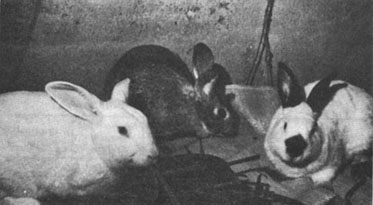
Selecting a breed[edit | edit source]
1. Whether you raise rabbits for meat and fur, wool, or laboratory uses, select the breeds best adapted to the purpose.
2. Table I below lists the common rabbit breeds, their predominant color, weight and uses.
3. The medium and large breeds such as the New Zealand, California, Dutch Grey, English Spot, Chinchilla, and Flemish Giant have the most suitable size and conformation for producing meat and fur. White breeds of rabbits (e.g. New Zealand White and Californian, Fig. 1), are the most prolific and the most desirable for commercial and fur production because white skins usually bring higher prices. Preference among the white breeds is largely a matter of personal choice. Skins are a by-product of the meat production.
|
Breed |
Color |
Approximate Mature Weight |
Principal Uses |
|
KILOS |
|||
|
American Chinchilla |
Resembles the true Chinchilla |
5½ - 6 |
Meat and fur |
|
Californian |
White body; colored nose, ears, feet, and tail |
3½ - 5 |
Meat and fur |
|
Dutch |
Black, blue, chocolate, tortoise, steel grey, and grey; white sad dle, or band over the shoulder carrying down under the neck and over the front legs and hind feet |
1½ - 2½ |
Laboratory |
|
English Spot |
Basic body color white; colors of spots: black, blue chocolate, tortoise, steel gray, lilac, and gray; nose, ears and eye circles and cheek spots; spine stripe from base of ears to end of tail; side spots from base of ears to middle of hind quarter. |
2½ - 3½ |
Laboratory and meat |
|
Flemish Giant |
Steel gray, light gray, sandy, black, blue, white and fawn. No two colors allowed on solids |
6 |
Meat |
|
New Zealand |
White, red, or black |
4 - 5½ |
Meat, fur and Laboratory |
If you raise rabbits for laboratory purposes, check with nearby hospitals, laboratories, and city health offices to find out the type, age, and size of animal desired.
With sufficient feeding, mature animals (4½-5 months old) of the smaller breeds should weight 1 1/3 kilos to 1 ¾ kilos each; those of the medium breeds, 4 kilos to 5 ½ kilos; and those of the larger breeds, 6 1/3 kilos to 7 1/3 kilos. There are 28 different breeds, and approximately 77 varieties that vary in type, color, and size.
FIGURE 1 - Representative breeds of meat rabbits. Left, New Zealand White; Center, Chinchilla; Right, Californian.
SELECTING FOUNDATION STOCK
Selection of prime stock is the initial and most basic step toward success or failure of a rabbit operation. Naturally, an animal's appearance will play a major factor in the process of selection. Other essential requirements are health, vigor, longevity, ability to reproduce, and desirable type and conformation. But, overall, the primary criterion remains the rabbit's records. It is vitally important to study! records on family production, hereditary factors, size of animals, growth potential, etc. Therefore, purchase your foundation stock from a reliable and established rabbitry that keeps such records.
